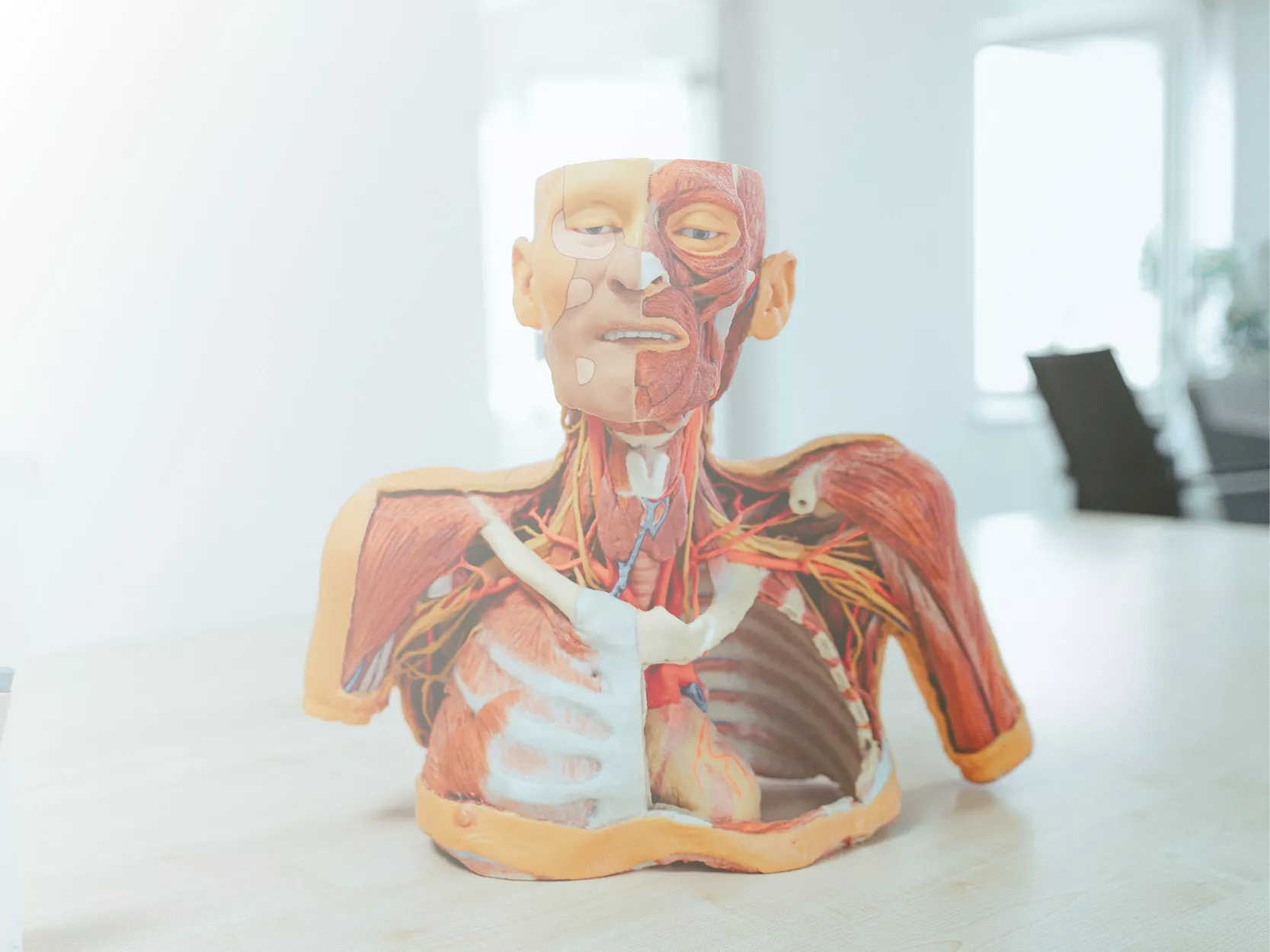Produktinformationen "Craniopharyngioma"
Klinische Vorgeschichte
Eine 62-jährige Frau stellte sich mit Desorientierung bezüglich Zeit, Ort und Person vor. Die körperliche Untersuchung zeigte keine lokalen neurologischen Ausfälle. Bildgebende Verfahren zeigten eine raumfordernde Läsion im Boden des 3. Ventrikels. Bei der Operation wurde Gewebe entfernt, eine vollständige Entfernung war jedoch nicht möglich. Die Histologie bestätigte die Diagnose eines Kraniopharyngeom. Postoperativ entwickelten sich komplexe metabolische Störungen, vermutlich hypothalamisch bedingt. Der Zustand der Patientin verschlechterte sich zunehmend und sie verstarb 10 Wochen nach Aufnahme nach einer Magenaspiration.
Pathologie
Das sagittal geschnittene Gehirn zeigt einen rosa-grauen, ovalen Tumor von 2,5 x 1,5 cm Größe in der Hypothalamusregion. Der Tumor ist kapsuliert, außer an der ventralen Seite, wo bei der Operation Gewebe entfernt wurde. Die Schnittfläche zeigt ein mikrozystisches oder schwammartiges Erscheinungsbild. Der Tumor verformt den 3. Ventrikel und verlegt das Foramen Monroi. Der Chiasma opticum ist nach unten verlagert. Ein früherer Ventrikulo-atrialer Shunt verhinderte trotz der Verlegung die Erweiterung der Seitenventrikel.
Weitere Informationen
Kraniopharyngeome machen 1–3 % aller Hirntumore aus und 5–10 % der Hirntumore bei Kindern. Die Erkrankung zeigt eine bimodale Altersverteilung mit Häufigkeitsgipfeln zwischen 5–14 und 50–75 Jahren. Die Inzidenz ist in Japan und Teilen Afrikas höher. Es handelt sich um epitheliale Tumoren, die meist vom Hypophysenstiel ausgehen, aber auch aus der Sella turcica, dem optischen System oder dem 3. Ventrikel stammen können. Sie bestehen häufig aus festen und zystischen Anteilen, letztere enthalten Cholesterinkristalle. Es gibt zwei Haupttypen: das adamantinomatöse und das papilläre Kraniopharyngeom, die sich histologisch und genetisch unterscheiden, wobei die Prognoseunterschiede unklar sind. Die Behandlung umfasst operative Resektion und Strahlentherapie zur Behandlung von Resttumor. Die Prognose hängt von der Tumorkontrolle sowie lokalen und endokrinen Komplikationen ab.
Eine 62-jährige Frau stellte sich mit Desorientierung bezüglich Zeit, Ort und Person vor. Die körperliche Untersuchung zeigte keine lokalen neurologischen Ausfälle. Bildgebende Verfahren zeigten eine raumfordernde Läsion im Boden des 3. Ventrikels. Bei der Operation wurde Gewebe entfernt, eine vollständige Entfernung war jedoch nicht möglich. Die Histologie bestätigte die Diagnose eines Kraniopharyngeom. Postoperativ entwickelten sich komplexe metabolische Störungen, vermutlich hypothalamisch bedingt. Der Zustand der Patientin verschlechterte sich zunehmend und sie verstarb 10 Wochen nach Aufnahme nach einer Magenaspiration.
Pathologie
Das sagittal geschnittene Gehirn zeigt einen rosa-grauen, ovalen Tumor von 2,5 x 1,5 cm Größe in der Hypothalamusregion. Der Tumor ist kapsuliert, außer an der ventralen Seite, wo bei der Operation Gewebe entfernt wurde. Die Schnittfläche zeigt ein mikrozystisches oder schwammartiges Erscheinungsbild. Der Tumor verformt den 3. Ventrikel und verlegt das Foramen Monroi. Der Chiasma opticum ist nach unten verlagert. Ein früherer Ventrikulo-atrialer Shunt verhinderte trotz der Verlegung die Erweiterung der Seitenventrikel.
Weitere Informationen
Kraniopharyngeome machen 1–3 % aller Hirntumore aus und 5–10 % der Hirntumore bei Kindern. Die Erkrankung zeigt eine bimodale Altersverteilung mit Häufigkeitsgipfeln zwischen 5–14 und 50–75 Jahren. Die Inzidenz ist in Japan und Teilen Afrikas höher. Es handelt sich um epitheliale Tumoren, die meist vom Hypophysenstiel ausgehen, aber auch aus der Sella turcica, dem optischen System oder dem 3. Ventrikel stammen können. Sie bestehen häufig aus festen und zystischen Anteilen, letztere enthalten Cholesterinkristalle. Es gibt zwei Haupttypen: das adamantinomatöse und das papilläre Kraniopharyngeom, die sich histologisch und genetisch unterscheiden, wobei die Prognoseunterschiede unklar sind. Die Behandlung umfasst operative Resektion und Strahlentherapie zur Behandlung von Resttumor. Die Prognose hängt von der Tumorkontrolle sowie lokalen und endokrinen Komplikationen ab.
Erler-Zimmer
Erler-Zimmer GmbH & Co.KG
Hauptstrasse 27
77886 Lauf
Germany
info@erler-zimmer.de
Achtung! Medizinisches Ausbildungsmaterial, kein Spielzeug. Nicht geeignet für Personen unter 14 Jahren.
Attention! Medical training material, not a toy. Not suitable for persons under 14 years of age.







































